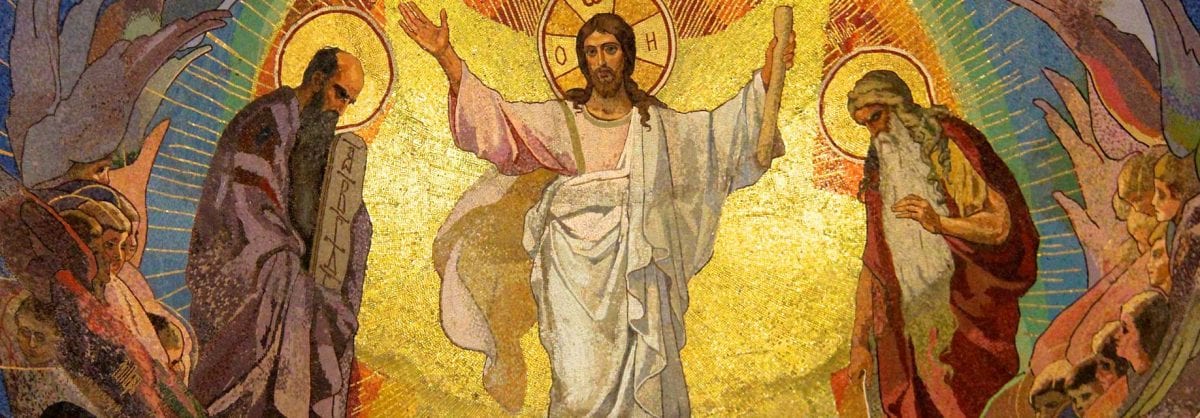Surely the Transfiguration is a mysterious moment. Taking with him Peter, James and John, Jesus climbs to the top of Mount Tabor, where he is transformed into a being of light and converses with Elijah and Moses.
Before this wondrous event, Peter is exuberant: he wants to know whether he can build three booths to commemorate the visit. But just as the words are out of his mouth, a cloud appears and a voice is heard, the thunderous voice of the Father: “This is my beloved son. Listen to him.”
The disciples panic. They throw themselves onto the ground, trembling, until Christ approaches and touches them. “Rise and do not be afraid,” he says. They look up and see only him. And with him, they descend the mountain. (Matthew 17:1-9).
A basic spiritual truth becomes clear in the experience of Peter. In front of a beautiful, precious moment, Peter wants to control and contain. He thinks he can memorialize Christ in his glory, make a project out of him. But, with the words of the Father, Peter is suddenly and forcefully directed to abandon this plan. Look at Christ, follow Christ! – the voice of the Father urges. And the Christ that Peter is to follow is not a luminous, other-worldly being, but the very Christ he has been following all along. His mission is simply to keep walking alongside this man, listening to this man. He has to keep moving.
The Transfiguration teaches us that our life is a pilgrimage. We are to live in such a way that we seek Christ in all circumstances, with the desire to find him in all things. And this means our hearts must always remain in motion.
Few have lived this pilgrimage with the fervor, the raw spiritual energy, of Elizabeth Ann Seton. Even as a child, she longed for Heaven, where her mother and beloved sister already had a place. As a young, devout Episcopalian wife, she hung on the words of the Sunday sermons and sought to help Christ’s poor, the desperate widows and orphans. And when she encountered the Catholic Church, her pilgrimage was only intensified.
Elizabeth hungered for Christ’s presence in every Communion and sought to yield in every way to the spiritual directors God had put over her. Her submission to their plans led her to accept the tasks of starting a school and guiding a fledgling religious congregation, even as she continued to nurture and guide her own biological children. And she did all of this in difficult circumstances, amid sickness, suffering and loss. Yet, she was undaunted! Weariness and sadness were ever put to good spiritual end: they served only to intensify her longing for Christ.
Elizabeth’s fervor continued unabated to the very end. Her spiritual director, Father Bruté, described the scene on October 6, 1820, as he arrived to bring her Communion. Tuberculosis had weakened her to the point that making the overnight fast before Communion was a heroic feat. But Elizabeth did it—quivering with a desire for Christ:
“Her joy was so uncommon that when I approached, and as I placed the ciborium upon the little table, she burst into tears, and, sobbing aloud, covered her face with her two hands. I thought first it was some fear of sin and, approaching her, I asked, “Be still, Mother! Peace, peace be to you! Here is the Lord of Peace! Have you any pain? Do you wish to confess?
“No, no! Only give Him to me”. . . she said with an ardor, a kind of exclamation, and her whole face so inflamed that I was much affected.”
Later, Father Bruté admitted that the very sight of Elizabeth’s desire for Christ struck him to the heart. “Do give me the faith of that woman,” he prayed.
Mother Seton’s evident humanity, her tears and longing, had but one end: to find Christ in this world, even as she was on the threshold of the next. Her witness should strike us to the heart. In her we are in front of an exemplary soul, a saint. This, we must admit, is the very stuff of Christian holiness.
St. Elizabeth Ann Seton expresses in a very clear way what the true form of our life ought to be. We must seek him out, walk alongside him, listen to him—which is to say that our spiritual lives are work! We proceed only with difficulty, and we must face each day with the desire to begin again. In this way, Mother Seton challenges our complacency, our yearning for a simple and easy route to holiness—the way Peter did on Mount Tabor. Her witness warns us against all attempts to maintain our treasured status quo by marshaling reality according to our own purposes.
Indeed, St. Elizabeth Ann Seton tells us that our agenda is not our own. We follow Christ—the one who alone can say to us “Do not be afraid.” The one who offers himself even unto death that we might live. The one—as Elizabeth herself identified on the day of her First Communion—who is the “deliverer. . . my defense and shield and strength and salvation made mine for this world and the next.”
This is the man who comes to us in our need and brokenness. Let us, with Peter, James and John, and Elizabeth Ann Seton, rise and go with him!
LISA LICKONA, STL, is Assistant Professor of Systematic Theology at Saint Bernard’s School of Theology and Ministry in Rochester, New York, and a nationally-known speaker and writer. She is the mother of eight children.
This reflection was previously published. Click here to view all Seton Reflections.
